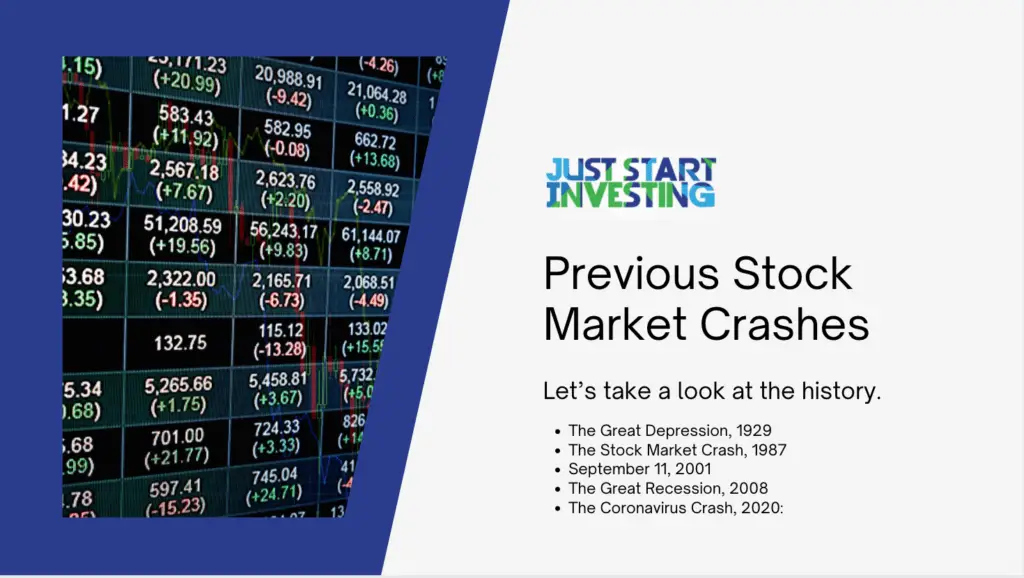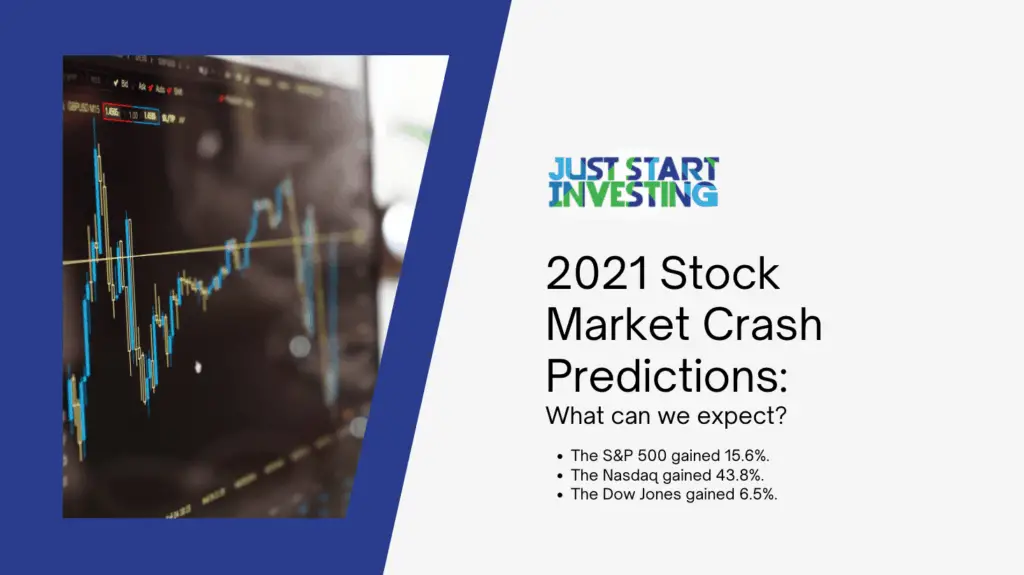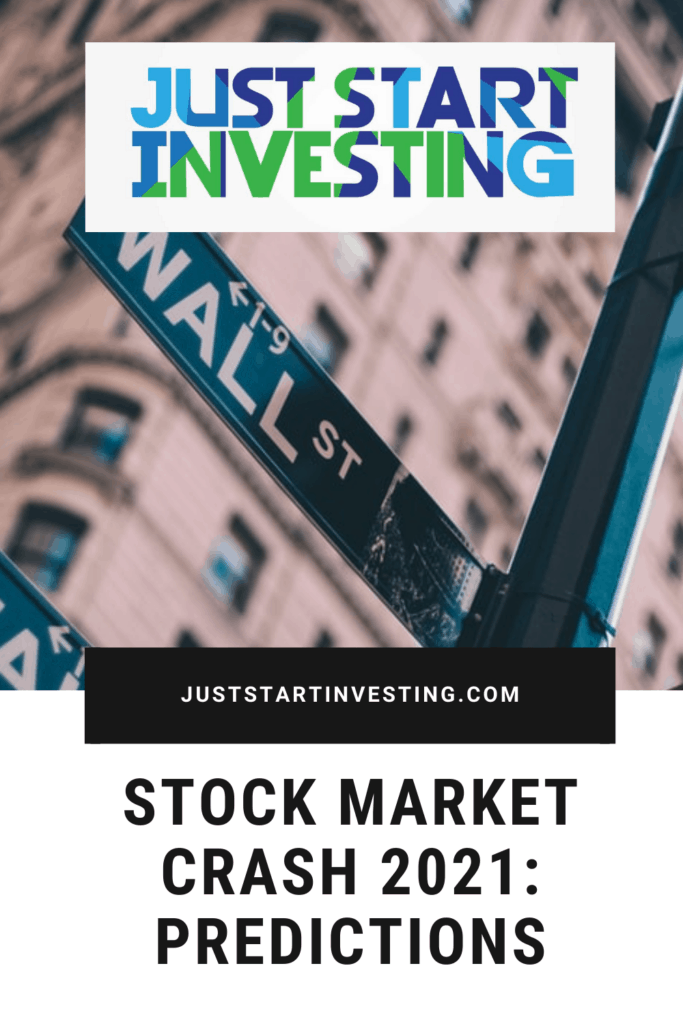We’ve experienced the Great Depression, the Great Recession, and now the stock market crash 2021 is looming close. The history of stock market crashes reveals that although each is unique, some aspects are common among them. By understanding that the phenomenon is human-driven and influenced by economic factors and crowd psychology, we can see more clearly what could be around the corner by the end of this year.
After all the turmoil in the market, is it possible that another market crash is on the horizon? Is there any truth in all the predictions? It can only be determined by the numbers and the time.
The world is constantly changing, so looking into the past can help us predict what will come down the road.
To predict the future a little better, let’s look at the historical events when this crash in the stocks has occurred!
Previous Stock Market Crashes: Let’s take a look at the history.

When looking at the numbers throughout the years, we might notice a recurring pattern. Does this predict the 2021 stock market crash?
Understanding this may just save us from the next crash and help us learn some valuable lessons.
The Great Depression, 1929
On October 24, 1929, a panic broke out among several financial institutions, which led to bids above the market price, causing the stock market to slowly take a downturn. However, stocks seemed to have bounced back the following two days after suffering minimal losses.
But on Monday, however, stocks fell by an additional 13%, according to the stock market crash timeline of that era. Then, a few days later, “Black Tuesday” revealed that all hope of stock prices rising again had evaporated when they fell by 12%.
The DJIA dropped nearly 25% within a few days, and in consequence, the Wall Street crash officially began.
When the 1929 stock market crash began, investors who held stocks recovered their losses quickly. However, 25 years passed before the Dow was able to regain the highs it reached in 1929. Furthermore, Dow investors had to wait a decade to recoup their money, including dividends.
The Stock Market Crash, 1987
Markets all over the world were affected by ‘Black Monday’ of 1987.
Over one day, the market lost 22.6% of its value. According to financial experts, the leading cause of the collapse was the computerized stock trading programs. There was a point at which automatic stock sales would take place; they all acted simultaneously, causing the crash.
In contrast, the 1987 stock market began recovering almost immediately, unlike the 1929 stock crash that took nearly 25 years to recover. Despite the recession, there was no long-term effect on the US economy. September 1989 marked the start of the Dow’s full recovery from its stock market losses.
September 11, 2001
In the aftermath of the terrorist attacks, the market took a major hit but quickly recovered. The stock market increased throughout the end of 2001, returning to September 10 levels one month later.
This shows a quick recovery after a downfall that gives hope for future difficulties.
The Great Recession, 2008
Briefly, the fall was due to Congress refusing to pass a bailout bill for banks. In the following month, the bailout was passed, but unfortunately, it was too late. As a result of the September stock market crash, almost 159,000 jobs were lost, and more than half of the DJIA’s value was destroyed in just a few months.
In the past century, only the 2020 crash produced a worse loss of points than this one. However, after a couple of years, the market became stronger than ever before – it was undergoing a bull market (an economic expansion of large proportions) from 2009 until just before the Coronavirus pandemic.
The Coronavirus Crash, 2020:
An outbreak of COVID-19 in March of 2020 led to the most extreme financial crisis in history.
March 9 marked the beginning of the stock market crash when the Dow witnessed a 7.79% drop – a drop of 2,014 points.
Three days after that incident, another drop occurred, which indicates that the crisis had not ended. The Dow recorded another decline of 2,352 points (a 9.99% drop).
A third wave occurred on March 16th when the Dow lost nearly 3,000 points (12.9%).
Nevertheless, the stock market gained ground fairly quickly, and the year ended with record highs.
2021 Stock Market Overview
There have been periodic crashes of the stock market for the past hundred years. Some predict that the market will once again plunge in 2021.
When doing research and looking at what the public thinks, a survey conducted by IPSOS found that up to 43% of Brazilian respondents believed major global stock markets could crash in 2021. This is the most oversized bracket in Latin America during the October and November 2020 surveys. Argentina ranked second with 40% of respondents. The Peruvian population was the least pessimistic, with more than half of respondents answering that this possibility was unlikely.
| Possibility | Brazil | Argentina | Chile | Mexico | Peru |
| Likely | 43% | 40% | 39% | 34% | 27% |
| Unlikely | 40% | 38% | 44% | 36% | 51% |
*Predictions by the public in Latin America
There will inevitably be ups and downs on the US stock market with over 2,800 companies worth over $21 trillion combined. Market crashes do occur fairly frequently, but so do major market recoveries.
During the past 17 months, investors have seen their portfolios go up in value. S&P 500 values have doubled since March 23, 2020, when the stock market bottomed out. Currently, the stock market is at record highs. Over the past 12 months, the S&P 500 has gained 47%.
At the moment, the ongoing COVID-19 pandemic threatens humanity and puts a strain on the stock market. The stock market drops by 10% whenever a market crash occurs, and this happens more frequently than most people realize.
Crashing can last only a day, and the markets will recover afterward, or it can take years for them to start rising again. So to reduce all the fear of losing investments, let’s try to understand the numbers a little better.
2021 Stock Market Crash Predictions: What Can We Expect?

When the pandemic first began, the stock market took us all on a roller coaster ride. A huge decline took place in the market worldwide. However, after the initial dive in March, the market gradually began to rebound. The stock market had recouped everything it had lost after New Year’s Eve 2020. In 2020, all three major indexes grew.
- The S&P 500 gained 15.6%.
- The Nasdaq gained 43.8%.
- The Dow Jones gained 6.5%.
The rapid turnaround from recession to euphoria has been so abrupt that we haven’t quite digested it yet.
Several indicators are suggesting that a steep correction or crash this year is very likely, but things could go either way.
And here are the reasons why!
Let’s Compare the Two Possible Scenarios: Will the Stock Market Crash Again In 2021?
Data analysis shows that both positive and negative scenarios are likely to transpire by the end of the year.
Being prepared for any eventuality is essential, and one should consider both.
S&P 500 Shiller price-to-earnings ratio is perhaps the most concerning indicator of a significant correction to come for the stock market. Over the past decade, the Shiller P/E takes inflation into account.
The Shiller P/E ratio for the S&P 500 reached 38.91 on Monday, Aug. 16. An added point of reference, Shiller P/E is 16.84 on average since 151 years ago. It is important to note that the previous four instances where Shiller P/E exceeded and held above 30 did not end well for a share price. At least 20% of the value of the index was lost in each of these events.
Over the last two decades, the advent of the internet has dramatically helped democratize financial data, leading to a substantial increase in earnings multiples.
It’s also instructive to observe how the S&P 500 responds to bottoms at the beginning of bear markets. Eight bear markets have occurred since 1960, which excludes the Coronavirus crash. There was at least one pullback of 10% (or greater) after the bottom of each of these bear markets was reached.
Five out of the eight bear markets experienced two double-digit percentage pullbacks three years after hitting bottom. As we’ve mostly seen over the past 17 months, bouncing back from a bear-market bottom rarely results in a straight upward trajectory. Instead, market history suggests that some downward trends are to be expected.
Scenario 1: The Stock Market Crashes
Even though it isn’t sure, it is essential to be cautious if things take a down-turn.
There is no end in sight to the Coronavirus, and the Delta variant is driving up new case numbers.
In addition, unemployment may complicate matters. While millions of jobs have been recovered since the world economy was badly hit in 2020, unemployment is still a huge issue.
Finally, inflation is another critical factor. Again, there is a cost associated with stimulus checks. Inflation has increased because of higher government spending, causing investors to be cautious.
To go in-depth on some important data surrounding these predictions, visit this link!
We mentioned earlier that this pessimistic outlook on the situation might not be accurate. However, people themselves are responsible for making this happen, therefore they are also responsible for facilitating it.
It is still best to be patient when making big decisions. However, it is not all bad news.
The historical data indicates that long-term investors benefit from staying the course and buying great companies at any point in time, even when stock markets crash or correct.
Scenario 2: A Positive and Profitable Outcome
There are many reasons to feel optimistic about the stock market in 2021.
There is a great deal of influence that vaccinations have on how things turn out. For example, in response to the proliferation of Coronavirus vaccinations, the stock market experienced a positive reaction. Spending, optimism, and movement have already increased.
Reopened old industries are improving the economy. As a result, some businesses will again see value in their stocks (think travel, entertainment, and oil) as the world starts to reopen.
Growth between specific industries – technology, e-commerce, and biotechnology – has been phenomenal during the pandemic and is expected to continue.
Last but not least, low interest rates may save the stock market from a crash. Until at least 2023, the Federal Reserve hopes to keep interest rates near zero, encouraging consumers to spend.
Finally, keep in mind that crashes and corrections are frequent, but they rarely last long. For example, since 1950, the average double-digit correction has lasted 188 calendar days, while the average correction during modern times is only 155 calendar days.
Summary
A crash might be inevitable, but it isn’t certain. Although it is important to remember that the stock market does not adhere to averages, it is still worthwhile to observe the frequency at which the S&P 500 pulls back by 10%.
Investing is a cycle, meaning crashes and steep corrections are a part of it. Investors shouldn’t be surprised if a stock market crash occurs, given the information above.
In 2021, no one can say for sure what will happen. In addition to being common, market crashes can also be unpredictable. Consider both the pros and cons before making a decision.
How will the scene unfold? The only way to find out is to wait and see.
Want to know more about the stock market? Check out these articles:
- The Ultimate Guide on How to Read Stock Charts
- The Best Performing Stocks of 2020
- What is the Most Expensive Stock?

Just Start Investing is a personal finance website that makes investing easy. Learn the simple strategies to start investing today, as well as ways to optimize your credit cards, banking, and budget. Just Start Investing has been featured on Business Insider, Forbes, and US News & World Report, among other major publications for its easy-to-follow writing.

